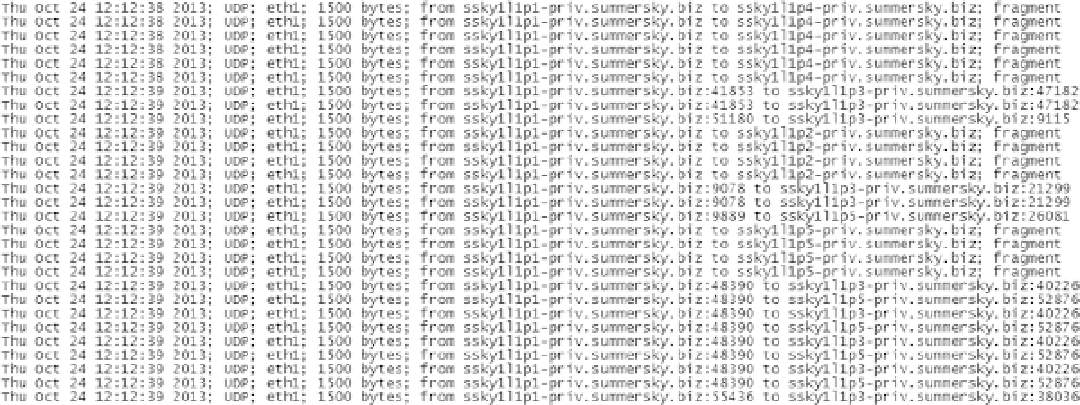Database Reference
In-Depth Information
Jumbo Frames
Ethernet traffic moves in units called frames. The maximum size of frames is called the maximum transmission unit
(MTU) and is the largest packet a network device transmits. When a network device gets a frame larger than its MTU,
the data is fragmented (broken into smaller frames) or dropped. The following output is from IPTraf (a network
monitoring utility on Linux) and illustrates fragmentation of data transmitted on an Ethernet configuration without
jumbo frames.
As illustrated in the following
ifconfig
output, Ethernet historically has a maximum frame size of 1,500 bytes,
1
so
most devices use 1,500 as their default MTU. To maintain backward compatibility, the “standard” gigabit Ethernet also
uses 1,500 byte frames. This is maintained so a packet to/from any combination of 10/100/1000 Mbps Ethernet
devices can be handled without any layer two fragmentation or reassembly. An Ethernet packet larger than 1,500
bytes is called a Jumbo Frame.
[oracle@prddb1]$ /sbin/ifconfig -a
bond0 Link encap:Ethernet HWaddr 00:D0:B7:6A:39:85
inet addr:192.168.2.30 Bcast:192.168.2.255 Mask:255.255.255.0
UP BROADCAST RUNNING MASTER MULTICAST MTU:1500 Metric:1
RX packets:3162 errors:0 dropped:0 overruns:0 frame:0
TX packets:1312 errors:0 dropped:0 overruns:0 carrier:0
collisions:0 txqueuelen:0
RX bytes:275327 (268.8 Kb) TX bytes:142369 (139.0 Kb)
Jumbo frame support is designed to enhance Ethernet networking throughput and significantly reduce the CPU
utilization of large file transfers like large multimedia files or large data files by enabling more efficient larger payloads
per packet. By sending larger payloads per packet, fewer packets need to be routed, reducing the overhead on CPU
and potentially improving networking throughput. By using jumbo frames, the transfer frame sizes for Ethernet could
be increased to 9,000 bytes.
Jumbo frames also reduce the impact of packet loss: to send and receive an 8k block, the entire data transfer needs
to be fragmented into 5k to 6k smaller chunks and reassembled. If one of the frames is dropped, the block is lost.
1
The Ethernet packet consists of a 1,500-byte payload + 14 bytes for header + virtual local area networks (VLAN) tag 4 bytes + cyclic
redundancy check (CRC) 4 bytes.

Search WWH ::

Custom Search